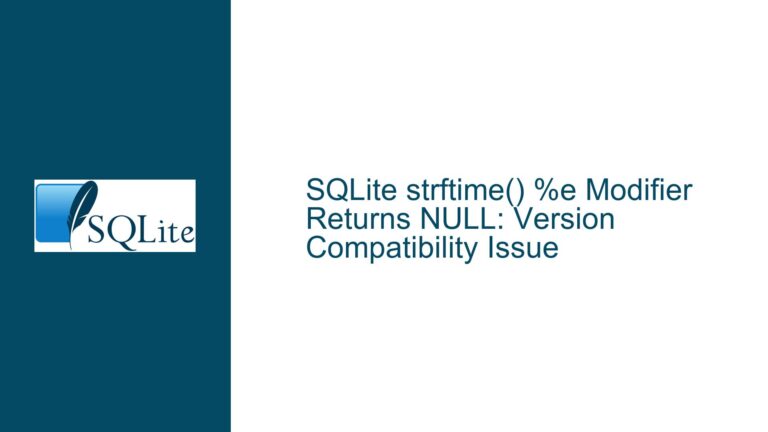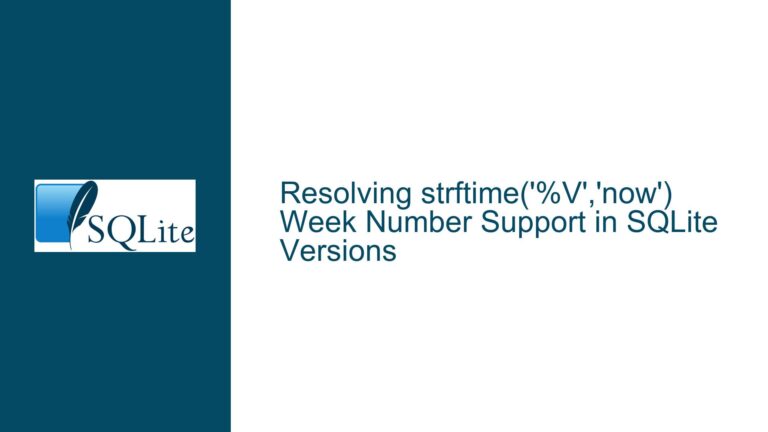and Resolving SQLite Window Function FILTER Clause Limitations
Issue Overview: Using FILTER Clause with Non-Aggregate Window Functions
The core issue revolves around the use of the FILTER clause in conjunction with non-aggregate window functions in SQLite, specifically the first_value function. The user aims to calculate the timestamp difference between the current row and the last row where the REQ column equals 1. The FILTER clause is intended to exclude rows where REQ is 0, ensuring that only relevant rows are considered in the window function calculation.
However, SQLite raises an error when attempting to use the FILTER clause with the first_value function: FILTER clause may only be used with aggregate window functions. This error indicates that the FILTER clause is restricted to aggregate window functions like SUM, AVG, COUNT, etc., and cannot be used with non-aggregate window functions such as first_value or last_value.
The user’s query attempts to use the first_value function to retrieve the timestamp of the last row where REQ equals 1, but the inclusion of the FILTER clause results in an error. The query works without the FILTER clause, but it does not meet the user’s requirement of excluding rows where REQ is 0.
Possible Causes: Why FILTER Clause is Restricted to Aggregate Window Functions
The restriction of the FILTER clause to aggregate window functions is rooted in the design and implementation of SQLite’s window function mechanism. Window functions in SQLite are categorized into two main types: aggregate window functions and non-aggregate (or ranking) window functions. Aggregate window functions, such as SUM, AVG, and COUNT, operate on a set of rows and return a single value for each row in the result set. Non-aggregate window functions, such as first_value, last_value, and row_number, return a value based on the position or order of rows within the window frame.
The FILTER clause is designed to work with aggregate window functions because it modifies the set of rows that the aggregate function operates on. By filtering out rows that do not meet a specified condition, the FILTER clause effectively changes the input to the aggregate function, allowing for more precise calculations. However, non-aggregate window functions like first_value and last_value do not operate on a set of rows in the same way. Instead, they return a value based on the position of a row within the window frame, and the concept of filtering rows does not directly apply to their operation.
In the case of first_value, the function is designed to return the value of a specified expression from the first row in the window frame. The FILTER clause, which is intended to modify the set of rows that an aggregate function operates on, does not have a clear or meaningful application to first_value. This is why SQLite restricts the use of the FILTER clause to aggregate window functions.
Troubleshooting Steps, Solutions & Fixes: Alternative Approaches to Achieve the Desired Result
Given the restriction on using the FILTER clause with non-aggregate window functions, we need to explore alternative approaches to achieve the user’s goal of calculating the timestamp difference between the current row and the last row where REQ equals 1. Below are several potential solutions, each with its own advantages and trade-offs.
Solution 1: Using a Self-Join to Identify the Previous REQ=1 Row
One approach is to use a self-join to identify the previous row where REQ equals 1. This involves joining the table with itself on the condition that the timestamp of the previous row is less than the current row’s timestamp and REQ equals 1. The join can be performed using a subquery or a common table expression (CTE) to ensure that only the relevant rows are considered.
WITH previous_req AS (
SELECT
T1.Line,
T1.TStamp,
T1.REQ,
MAX(T2.TStamp) AS previous_req_timestamp
FROM
niceTab T1
LEFT JOIN
niceTab T2
ON
T1.TStamp > T2.TStamp AND T2.REQ = 1
GROUP BY
T1.Line, T1.TStamp, T1.REQ
)
SELECT
Line,
TStamp,
REQ,
previous_req_timestamp,
CASE
WHEN REQ = 1 THEN previous_req_timestamp
ELSE NULL
END AS lastREQ
FROM
previous_req
ORDER BY
TStamp;
In this solution, the previous_req CTE calculates the maximum timestamp (previous_req_timestamp) for each row in niceTab where REQ equals 1 and the timestamp is less than the current row’s timestamp. The main query then selects the relevant columns and uses a CASE statement to include previous_req_timestamp only when REQ equals 1.
Solution 2: Using a Correlated Subquery to Find the Previous REQ=1 Row
Another approach is to use a correlated subquery to find the timestamp of the previous row where REQ equals 1. This method involves writing a subquery that selects the maximum timestamp from niceTab where REQ equals 1 and the timestamp is less than the current row’s timestamp.
SELECT
Line,
TStamp,
REQ,
(
SELECT
MAX(TStamp)
FROM
niceTab T2
WHERE
T2.TStamp < T1.TStamp AND T2.REQ = 1
) AS lastREQ
FROM
niceTab T1
ORDER BY
TStamp;
In this solution, the correlated subquery is executed for each row in niceTab, returning the maximum timestamp where REQ equals 1 and the timestamp is less than the current row’s timestamp. This approach is straightforward but may be less efficient than the self-join method, especially for large datasets, as the subquery is executed for each row.
Solution 3: Using a Window Function with a Custom Frame
While the FILTER clause cannot be used with first_value, it is possible to achieve a similar result by defining a custom window frame that excludes rows where REQ equals 0. This can be done using the PARTITION BY clause to create partitions based on the REQ column and then applying the first_value function within each partition.
WITH req_partitions AS (
SELECT
Line,
TStamp,
REQ,
SUM(REQ) OVER (ORDER BY TStamp) AS req_partition
FROM
niceTab
)
SELECT
Line,
TStamp,
REQ,
CASE
WHEN REQ = 1 THEN first_value(TStamp) OVER (PARTITION BY req_partition ORDER BY TStamp)
ELSE NULL
END AS lastREQ
FROM
req_partitions
ORDER BY
TStamp;
In this solution, the req_partitions CTE creates partitions based on the cumulative sum of the REQ column. Each partition corresponds to a sequence of rows where REQ equals 1, followed by rows where REQ equals 0. The first_value function is then applied within each partition to retrieve the timestamp of the first row where REQ equals 1. This approach effectively filters out rows where REQ equals 0 by treating them as part of a separate partition.
Solution 4: Using a Recursive CTE to Traverse the Table
A more advanced approach involves using a recursive common table expression (CTE) to traverse the table and identify the previous row where REQ equals 1. This method is particularly useful for complex scenarios where the relationship between rows cannot be easily expressed using standard SQL constructs.
WITH RECURSIVE previous_req AS (
SELECT
Line,
TStamp,
REQ,
NULL AS previous_req_timestamp
FROM
niceTab
WHERE
Line = 1
UNION ALL
SELECT
T1.Line,
T1.TStamp,
T1.REQ,
CASE
WHEN T1.REQ = 1 THEN T1.TStamp
ELSE T2.previous_req_timestamp
END AS previous_req_timestamp
FROM
niceTab T1
JOIN
previous_req T2
ON
T1.Line = T2.Line + 1
)
SELECT
Line,
TStamp,
REQ,
previous_req_timestamp AS lastREQ
FROM
previous_req
ORDER BY
TStamp;
In this solution, the recursive CTE previous_req starts by selecting the first row in niceTab and initializes the previous_req_timestamp to NULL. The recursive part of the CTE then joins each row with the previous row and updates the previous_req_timestamp based on the value of REQ. If REQ equals 1, the current timestamp is used as the previous_req_timestamp; otherwise, the previous_req_timestamp from the previous row is carried forward. This approach allows for a precise calculation of the previous REQ=1 timestamp for each row.
Conclusion
The restriction of the FILTER clause to aggregate window functions in SQLite presents a challenge when attempting to use it with non-aggregate window functions like first_value. However, by leveraging alternative SQL techniques such as self-joins, correlated subqueries, custom window frames, and recursive CTEs, it is possible to achieve the desired result of calculating the timestamp difference between the current row and the last row where REQ equals 1. Each of these solutions has its own advantages and trade-offs, and the choice of which to use will depend on the specific requirements and constraints of the dataset and query performance considerations.






